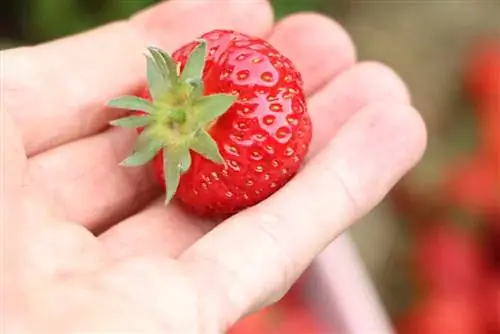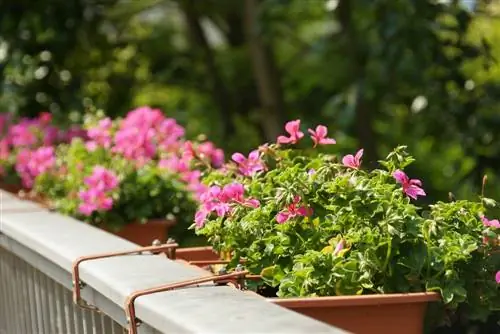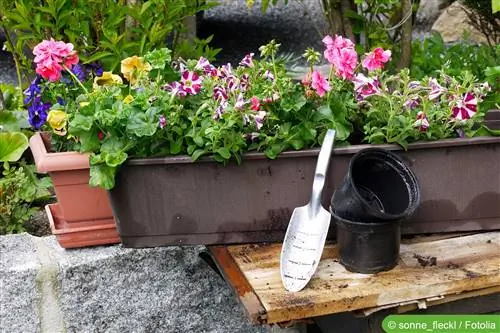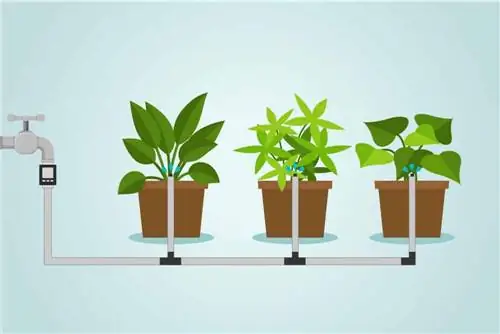- Author admin [email protected].
- Public 2023-12-17 03:39.
- Last modified 2025-06-01 06:48.
Continuing to decorate the balcony with fresh greenery and cheerful splashes of color in winter is an exciting option that creative gardeners cannot miss. For a large number of decorative plants, the hour of their big appearance only comes with the beginning of the cold season. With their evergreen foliage, bright berries and winter flowers, they are on a par with grandiose summer flowers in terms of radiance and decorative value. Be inspired by this selection of suitable plants to plant hardy plants in a flower box.
Winter flowering plants for the flower box
They are the winter queens of the plant kingdom because their flowers unfold in the middle of the cold season. The following selection introduces you to the most beautiful specimens that will transform your hardy planted flower box into a sea of flowers.
Christmas rose (Helleborus niger)
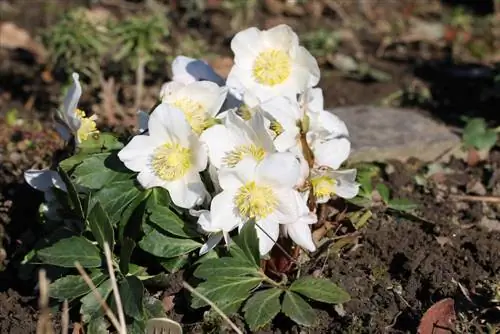
When winter has a firm grip on the balcony and garden, their white or pink cupped flowers appear as if by magic. As a native perennial, the Christmas rose is perfectly adapted to winter climates and can be prevented from displaying its picturesque blooms even by a blanket of snow. The variety 'Double Fashion' boasts double flowers, although it is less frost-resistant than the pure variety. With a winter hardiness of up to -28 degrees Celsius, the magnificent variety is still perfect for planting in a winter-hardy flower box.
- Flowering time: December to March
- Growth height: 15 to 25 cm
- Winter hardiness: - 34.5 to -40.0 degrees Celsius
Pansies (Viola tricolor)
At first glance, we don't notice the indestructible nature of graceful pansies. Nevertheless, the three-colored cultivars of the local wild species give the balcony a splendid winter color. Only when temperatures fall below -20 degrees Celsius do the flowers temporarily retreat and wait for milder weather to bloom again.
- Flowering time: October to March
- Growth height: 10 to 20 cm
- Winter hardiness: - 28.9 to -34.4 degrees Celsius
Amur Adonis (Adonis amurensis)
With their golden yellow, up to 4 cm large flowers, Amur Adonis florets compete with the winter sun. These hardy winter bloomers are native to China, Korea and eastern Siberia. In contrast to the European Adonis florets, the Asian counterparts stand up to the bitter frost unfazed.
- Flowering period: January/February to March/April
- Growth height: 20 to 30 cm
- Winter hardiness: - 34.5 to -40.0 degrees Celsius
Palm leaf snow lily (Helleborus foetidus)
Primal charm and unshakable winter hardiness characterize this wild species from the Helleborus genus. The tightly upright habit of a palm leaf snow rose and its greenish, red-edged bell flowers inspire creative design plans. Combined with small onion flowers, such as snowdrops or marshmallows, the winter bloomers create an atmospheric color in the flower box on the balcony.
- Flowering period: January to April
- Growth height: 30 to 50 cm
- Winter hardiness: - 17.8 to - 23.3 degrees Celsius
Tip:
All plant species in the genera Helleborus and Adonis are poisonous. Christmas roses, snow roses and Adonis roses are only suitable for winter planting in flower boxes when they are out of the reach of children and pets.
Balcony plants with wintry colors
In order to plant a flower box in a hardy and colorful way, the selection is not limited to the few winter-flowering plants. Small evergreen trees with bright fruit decorations or frost-resistant foliage plants do not rely on flowers to create decorative accents on the balcony.
Mockberry - Red Carpetberry (Gaultheria procumbens)
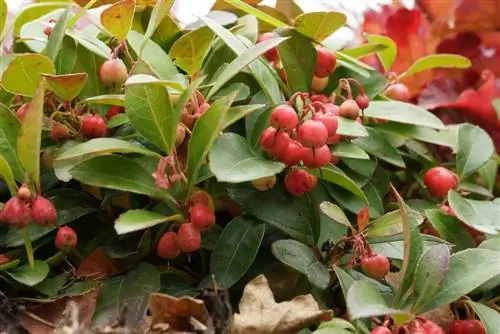
The false berry does not owe its reputation as one of the most beautiful plants for the winter flower box to the pink and white flowers in late summer. Only when the red berries appear between the evergreen, shiny leaves does the decorative value of the hardy ornamental shrub become apparent. As the winter progresses, the leaves take on a bronze-red color that harmonizes wonderfully with the fruit decoration.
- Flowering time: July to August
- Growth height: 10 to 20 cm
- Winter hardiness: up to - 24.5 degrees Celsius
Winter heather (Erica carnea 'Whisky')
Representing the diverse genus of heather herbs, we have included the colorful and hardy variety 'Whisky' in this selection. When other perennials are hibernating, the winter heather delights with needle-shaped leaves in orange to bronze yellow. When the cold season comes to an end, the small tree boasts a furious season finale and lets its ruby-red flowers shine.
- Flowering period: February to April
- Growth height: 15 to 20 cm
- Winter hardiness: up to - 28.5 degrees Celsius
Purple bells (Heuchera hybrid 'Plum Pudding')
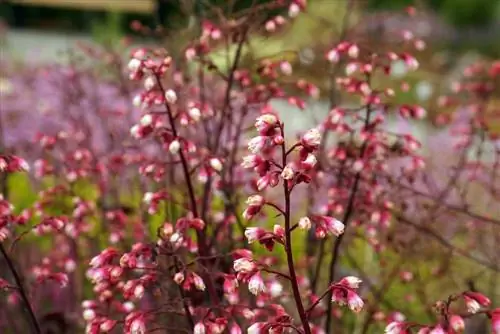
It is thanks to modern breeding successes, such as 'Plum Pudding', that purple bells are useful as magnificent foliage plants in winter flower boxes. The plum-colored, silvery shimmering leaves are beautifully drawn and have an impressive long-distance effect. Gone are the days when Heuchera species capitulated to frost in winter. Today, the colorful leafy perennials delight with their flawless foliage until spring. The best prerequisites for perseverance are a permeable, humus-rich substrate that is optimized with sand.
- Flowering period: June to August
- Growth height: 20 to 30 cm
- Winter hardiness: - 23.4 to -28.8 degrees Celsius
Cushion Purple Bells (Heucherella Hybride 'Quicksilver')
The delicate cushion purple bell forms a congenial partnership with its big sister 'Plum Pudding' when the two species are combined in the flower box. The metallic-looking foliage is interspersed with reddish leaf veins, so that an elegant play of colors on the balcony attracts attention. As a new generation hybrid, 'Quicksilver' is equipped with all the positive properties that guarantee an undamaged winter period.
- Flowering period: May to July
- Growth height: 10 to 20 cm
- Winter hardiness: - 23.4 to -28.8 degrees Celsius
Roller spurge (Euphorbia myrsinites)
Are you looking for hardy ornamental plants that are suitable for the flower box in full sun? Then pay attention to this roller spurge. The tongue-shaped, blue-green leaves gather on cylindrical shoots. As a steppe plant, spurge does not come under drought stress as quickly, even in winter frosts. The succulent is still grateful for a sip of water every now and then.
- Flowering period: May to June
- Growth height: 15 to 25 cm
- Winter hardiness: - 17.8 to - 23.3 degrees Celsius
Tip:
So that the plant soil doesn't freeze completely in winter, a flower box shouldn't be too small. Recommended dimensions are 100x45x40 or 90x40x35 cm. Drainage made of expanded clay on the bottom of the box prevents waterlogging by allowing rainwater to drain away easily.
Red moss stonecrop (Sedum album 'Coral Carpet')
If there is a colorful carpet of leaves at the feet of tightly upright winter perennials in the flower box, this design variant increases the decorative value immensely. With its coral-red leaves, the red moss stonecrop also likes to take on the main role in the balcony box to form decorative hanging cushions. If other plants are preferred in spring and summer, the frugal Sedum species has no objection to being transplanted into the bed or to the gravesite.
- Flowering time: May and June
- Growth height: 5 to 15 cm
- Winter hardiness: - 17.8 to - 23.3 degrees Celsius
Veined Arum (Arum italicum ssp. italicum 'Pictum')
A sublime representative of winter-hardy ornaments for the flower box only sprouts its leaves in autumn. The dark green, silvery leaves are joined by red, extravagant fruit clusters over the course of the cold season. The fruit decoration is the result of a white, calla-like flower that appears in spring. Since these are poisonous, the veined arum is not suitable for the balcony in the family household.
- Flowering period: April to May
- Growth height: 20 to 35 cm
- Winter hardiness: - 17.8 to - 23.3 degrees Celsius
White deadnettle (Lamium maculatum 'White Nancy')
So that the creative design plan in the natural garden on the balcony continues seamlessly in winter, the white deadnettle is a good choice. Completely hardy and wintergreen, the rustic perennial is not squeamish. Its toothed, silvery-white variegated leaves maintain their attractive color contrast even in partially shaded locations.
- Flowering time: May and June
- Growth height: 15 to 20 cm
- Winter hardiness: - 28.9 to -34.4 degrees Celsius
Cotoneaster (Cotoneaster dammeri ‘Coral Beauty’)
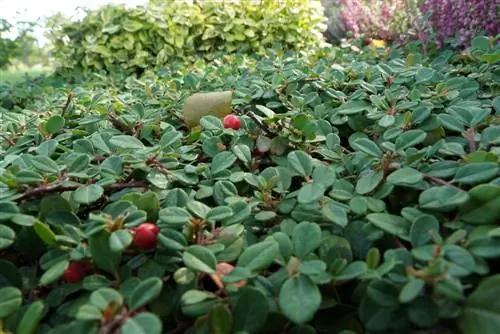
If you give free rein to its creeping growth in the flower box, the cotoneaster will develop cascades of evergreen leaves and red berries in winter that dangle elegantly over the edge of the box. Thanks to its robust constitution and reliable winter hardiness, the ornamental tree is suitable as a permanent guest in the balcony box, which can be combined with seasonal flowers and perennials at any time of the year.
- Flowering period: May to June
- Growth length: 40 to 60 cm
- Winter hardiness: up to - 24.5 degrees Celsius
Tip:
Icy wind can cause frost damage to balcony plants, regardless of their robust winter hardiness. A windproof covering made of bubble wrap effectively prevents this shortcoming. The foil becomes invisible under colorful ribbons, wooden stickers and straw flowers.
Delicate grasses with an attractive winter silhouette
Wintergreen ornamental grasses with a compact habit do much more than play an extra role on the balcony. Combined with perennials and small trees, the large flower box creates a picture of floral opulence that we otherwise know from spring and summer.
Japan gold sedge (Carex oshimensis 'Evergold')
The delicate, golden yellow Japanese gold sedge cheers up the dreary balcony with its colorful liveliness. Since the ornamental grass grows to a height of 30 cm and is hardy, it is perfect for winter flower boxes. When the pretty stalks gradually retreat in early spring, a delicate spike of flowers adorns the Asian sweet grass. By the way, the long, striped stalks are ideal for cutting to give bouquets of flowers a special charm in winter.
- Flowering period: April to May
- Growth height: 20 to 30 cm
- Winter hardiness: - 23.4 to -28.8 degrees Celsius
Dwarf blue fescue (Festuca cinerea hybrid 'Dwarf King')
Frost-resistant dwarf grasses are in high demand on the balcony in winter because they do a great job with their decorative tufts of grass. The blue-gray dwarf king from the blue fescue family is rightly named because it is unsurpassed in terms of color brilliance. The sunnier the location, the more intensely its frosted stalks shine. Since the ornamental grass prefers a dry, sandy substrate, it colonizes the balcony box as a solitary plant or in a group or is combined with the equally undemanding red moss stonecrop.
- Flowering period: June to July
- Growth height: 10 to 15 cm
- Winter hardiness: - 23.4 to -28.8 degrees Celsius
Tip:
When planting, place the bulbs of snowdrops, crocuses and marshmallows in the flower box between the hardy ornamental grasses. From January/February, pretty flowers join the graceful stalks to welcome the approaching spring.
Conclusion
Imaginative gardeners don't leave the balcony open to winter gloom. As this selection of hardy plants for the flower box shows, there is a wide range of evergreen, wintergreen and even flowering species and varieties available to you. The range of ideal companions through the cold season extends from the royal Christmas rose to ornamental trees with red berries to the rustic, white-variegated deadnettle. The indestructible plant community is rounded off by small ornamental grasses, which provide attractive contrasts with blue-green or pretty striped stalks.


